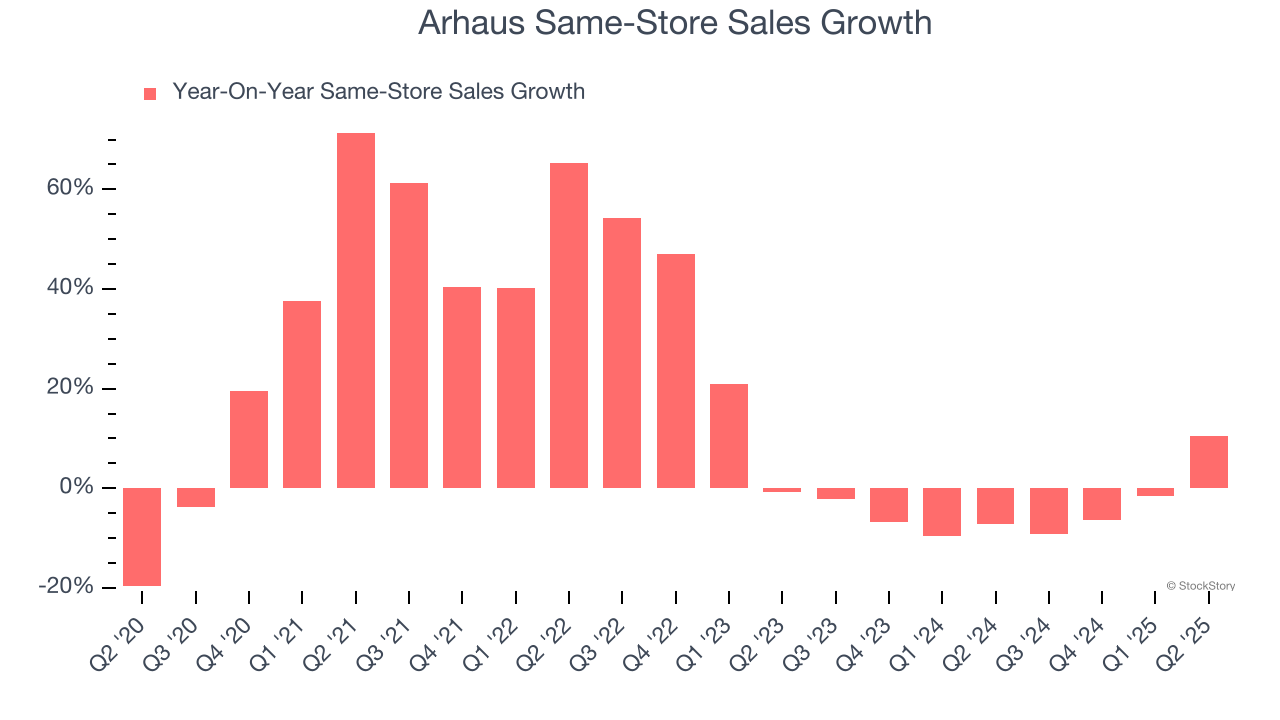
Luxury furniture retailer Arhaus (NASDAQ:ARHS) beat Wall Street’s revenue expectations in Q2 CY2025, with sales up 15.7% year on year to $358.4 million. Guidance for next quarter’s revenue was better than expected at $335 million at the midpoint, 0.9% above analysts’ estimates. Its GAAP profit of $0.25 per share was 65.6% above analysts’ consensus estimates.
Is now the time to buy Arhaus? Find out by accessing our full research report, it’s free.
Arhaus (ARHS) Q2 CY2025 Highlights:
- Revenue: $358.4 million vs analyst estimates of $333.8 million (15.7% year-on-year growth, 7.4% beat)
- EPS (GAAP): $0.25 vs analyst estimates of $0.15 (65.6% beat)
- Adjusted EBITDA: $60.31 million vs analyst estimates of $41.76 million (16.8% margin, 44.4% beat)
- The company reconfirmed its revenue guidance for the full year of $1.34 billion at the midpoint
- EBITDA guidance for the full year is $134 million at the midpoint, above analyst estimates of $130.3 million
- Operating Margin: 13%, up from 9.5% in the same quarter last year
- Free Cash Flow Margin: 5.8%, up from 3.6% in the same quarter last year
- Locations: 103 at quarter end, up from 97 in the same quarter last year
- Same-Store Sales rose 10.5% year on year (-7.1% in the same quarter last year)
- Market Capitalization: $1.39 billion
Company Overview
With an aesthetic that features natural materials such as reclaimed wood, Arhaus (NASDAQ:ARHS) is a high-end furniture retailer that sells everything from sofas to rugs to bookcases.
Revenue Growth
Examining a company’s long-term performance can provide clues about its quality. Any business can have short-term success, but a top-tier one grows for years.
With $1.34 billion in revenue over the past 12 months, Arhaus is a small retailer, which sometimes brings disadvantages compared to larger competitors benefiting from economies of scale and negotiating leverage with suppliers. On the bright side, it can grow faster because it has more white space to build new stores.
As you can see below, Arhaus’s sales grew at an excellent 19% compounded annual growth rate over the last six years (we compare to 2019 to normalize for COVID-19 impacts) as it opened new stores and expanded its reach.

This quarter, Arhaus reported year-on-year revenue growth of 15.7%, and its $358.4 million of revenue exceeded Wall Street’s estimates by 7.4%. Company management is currently guiding for a 5% year-on-year increase in sales next quarter.
Looking further ahead, sell-side analysts expect revenue to grow 3.5% over the next 12 months, a deceleration versus the last six years. Still, this projection is above the sector average and suggests the market is baking in some success for its newer products.
Software is eating the world and there is virtually no industry left that has been untouched by it. That drives increasing demand for tools helping software developers do their jobs, whether it be monitoring critical cloud infrastructure, integrating audio and video functionality, or ensuring smooth content streaming. Click here to access a free report on our 3 favorite stocks to play this generational megatrend.
Store Performance
Number of Stores
A retailer’s store count influences how much it can sell and how quickly revenue can grow.
Arhaus operated 103 locations in the latest quarter. It has opened new stores at a rapid clip over the last two years, averaging 11.9% annual growth, much faster than the broader consumer retail sector. This gives it a chance to scale into a mid-sized business over time.
When a retailer opens new stores, it usually means it’s investing for growth because demand is greater than supply, especially in areas where consumers may not have a store within reasonable driving distance.

Same-Store Sales
The change in a company's store base only tells one side of the story. The other is the performance of its existing locations and e-commerce sales, which informs management teams whether they should expand or downsize their physical footprints. Same-store sales provides a deeper understanding of this issue because it measures organic growth at brick-and-mortar shops for at least a year.
Arhaus’s demand has been shrinking over the last two years as its same-store sales have averaged 4% annual declines. This performance is concerning - it shows Arhaus artificially boosts its revenue by building new stores. We’d like to see a company’s same-store sales rise before it takes on the costly, capital-intensive endeavor of expanding its store base.

In the latest quarter, Arhaus’s same-store sales rose 10.5% year on year. This growth was a well-appreciated turnaround from its historical levels, showing the business is regaining momentum.
Key Takeaways from Arhaus’s Q2 Results
We were impressed by Arhaus’s optimistic EBITDA guidance for next quarter, which blew past analysts’ expectations. We were also excited its EPS outperformed Wall Street’s estimates by a wide margin. Zooming out, we think this was a solid print. The stock traded up 19.6% to $11.81 immediately following the results.
Arhaus had an encouraging quarter, but one earnings result doesn’t necessarily make the stock a buy. Let’s see if this is a good investment. The latest quarter does matter, but not nearly as much as longer-term fundamentals and valuation, when deciding if the stock is a buy. We cover that in our actionable full research report which you can read here, it’s free.
